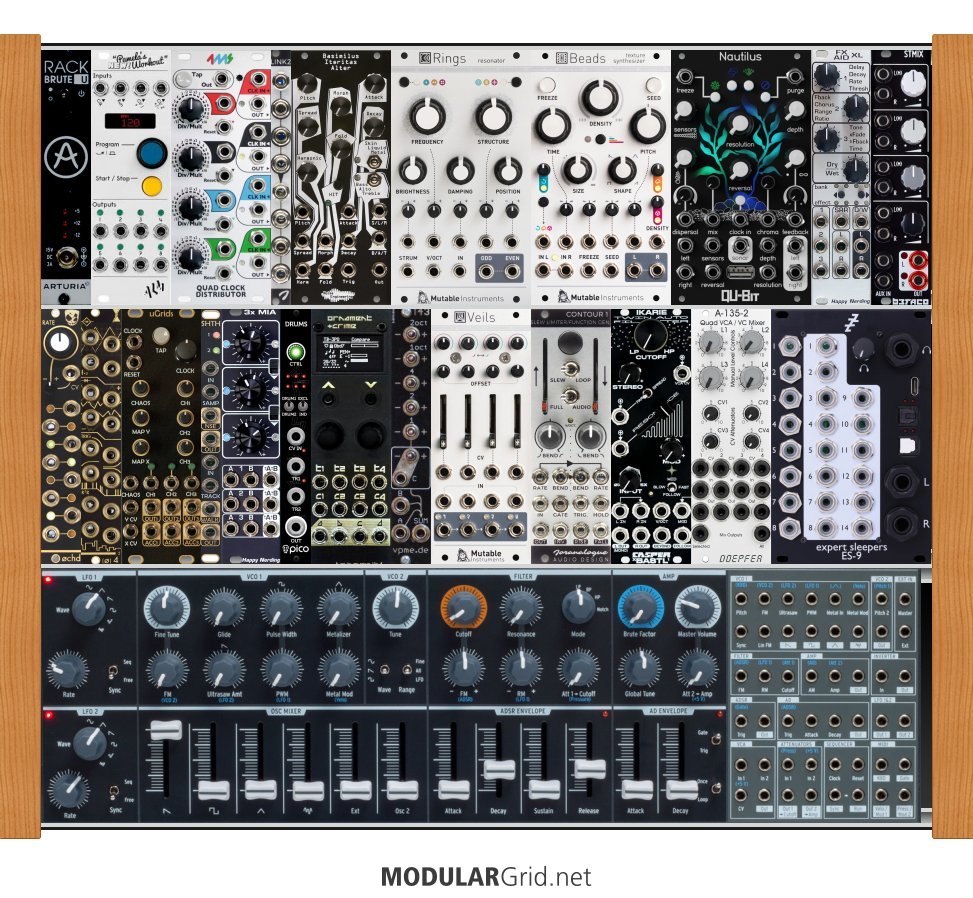Hi Rackbrute wigglers (and everyone else)!
I'm writing this in hopes that it is useful to new modular users, but maybe more experienced users can chime in with alternative suggestions, as well. When I started my modular journey, it was with a Minibrute 2s and a 6u Rackbrute. My goal was to create a versatile, semi-generative synth that could pretty much do it all. Foolishly, I thought that a Rackbrute would satisfy my GAS... Several years and a few Mantis cases later... yeah...
Anyways, a little while ago I was invited to spend a weekend hiking and chilling in a mountainside cabin, and my friend specifically requested that I bring a small synth! I ended up with my trusty Minibrute and Rackbrute. You can see what I actually did in my public racks (called "C. Travel Set - Old Rag Feb 24"), but I've since refined it to the current version. Since this satisfies my original goal, and since I know I'm not the only Rackbrute owner on here, I figured I'd share my thinking.
Note, this is a real rack, so I am only listing modules I actually own. However, there are a thousand other modules that can get you to this place, so beginners shouldn't go out and buy something just because I list it. Similarly, just because I have my way of thinking about building a synth, it doesn't mean it has to be your way.
When I build a rack, I like to keep in mind the signal path, and I tend to visualize it moving left to right. I also tend to think in blocks or chunks of functions (I like my modulators together, my sound sources together...). However, in a small rack, you compromise.
So...I start in the top left with my clocking. Pam's is my main clock. It is also extremely versatile and can provide plenty of randomness and finesse as needed. Clocking is further helped with the 4ms QCD, which is a damn fun module and allows Pam's to do more interesting euclidean rhythms. Bottom left, I have my modulators. Since I tend towards generative music, I like the movement of my lfos and random voltages to be front and center and driving the music. Therefore, I have the delightful OCHD and expander, giving a refreshing motion and more random possibilities. Finally, since my friend requested some rhythmic music, I have a uGrids to finish out my triggering and gating (not to mention the massive sequencing power of the Minibrute 2s).
Utilities break! I sprinkle utilties in wherever they functionally seem to make sense. On top, the Link 2. Below is one of my favorite little utility modules, the After Later SHTH. Sample and hold AND track and hold (they're not the same!) are a wonderful pairing with LFOs and random voltages. Of course modulators and random voltages need taming, so the ever handy Happy Nerding 3xMIA does that work. Ok, random voltages, cool, now what? Well, I like to control them with the O_C's very handy quantizers (everything about the O_C is handy). And then another absolute favorite utility, vpme.de's T43, a musically informed voltage adder. I didn't know I needed a voltage adder until I needed one, and this one is amazingly fun to play and jam with. And then of course, Veils and a deep function generator in the Contour 1.
Phew, ok, all that and we haven't even gotten to the sound sources yet! Well, we start with the handy (and usefully 3 hp) Erica Pico drums and the BIA above. Yes, yes, the BIA rules for kicks, but I actually prefer it as a gnarly oscillator. So now, given that the Minibrute has 2 oscillators, we have three sound sources and a sampler. But wait, there's more! We have the almost cheat-code strenth combo of Rings and Beads. Below that, we have the Ikarie on wacky vcf duties. As fun as filters are, I find that I don't really need them if the oscillator is interesting enough. Finally for the audio path, the delay of the Nautilus and the fx of the FXAid XL. All together, that's 5 voices and a sampler and multiple fx (don't forget the onboard reverb on Beads, as well).
My final block is the output block. One more quad vca to reduce my voices and then a 4 channel stereo mixer in the Stmix because that's right, this little rackbrute is in stereo. Then the ES-9 because I have one and why not record multitrack if you can. Plus, you can connect to the computer.
The end result is that I have an instrument that can: be generative, be arhythmic or rhytmic, be playable/programmable, be multi-voiced, be stereo, be connected to the computer, and be multitrack recorded. All in a Rackbrute and Minibrute. And it only cost... ok, well, let's not look at that part.
Shit, this was long-winded. But hopefully someone finds it useful to see how another person plans when constructing a rack. I know I would have when I started. Best of luck!


